Victor Vasarely is perhaps the best known of the Op artists. You can see a wide selection of his paintings on the followisn website:Vasarely Paintings
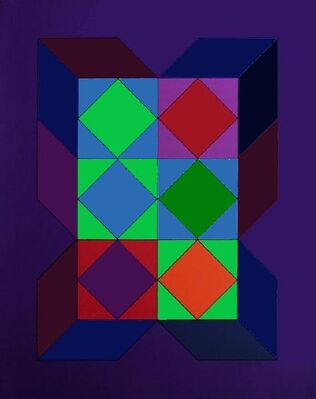
Vasarely, Cube V
Given the complexity of his paintings, and the precision which is required to render them, I wasn't very optimistic that one could find a good project to do for this particular kind of occasion. (Op art is a lots of fun for kids and it makes a great classroom project. The question is how to do a project that makes a good auctionable item at a charity, one that people want to have on their walls.)
Fortunately, there is a certain style of Vasarely that would work well—paintings divided into a grid, with the same or similar forms in each grid. The "art" part of the painting is how the whole thing works together —the colour principles that are applied on the micro level (each block in the grid) and how that interacts with the play of colour at the macro level.
The works below, or very similar projects, would work well in a number of mediums. If you doing very small blocks, you might consider foam printing; if you are doing larger blocks you could consider painting. Myself, I find those teeny, tiny squares, taken together, pretty amazing as a play in colour — but that is just me.
Some good Vasarely works on which to model a project...
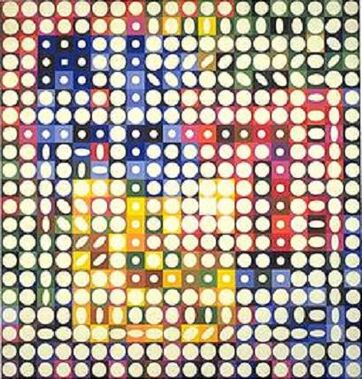
Orion C by Vasarely
This would be a fun one to do ...
- You could start by asking students which areas of the painting pop out and talk about why that is — that the pop out occurs because of high colour contrast between the backgrounds and/or because of size/shape differences in the subject (area of large circles surrounding area of small circles.
- Have students plan their grid using the same principles. Probably you would do a canvass with fewer squares (although to get the same effect you would need to have at least a 10 x 10 grid). This work uses 20 x 20 squares or 400 hundred squares in all. So this bears thinking about. Certainly if you used prints, every child could do 5-10 little prints without any problem. Once you;ve got your design, affix post-its with instructions to each square (big circle; dark green).
- You woulduse a negative print, such that what is inked is the background not the figure (the circle or other shape). With print foam, you take your figure (say a wooden cut-out of a circle, available at craft stores in small and larger sizes in the wood painting section) and press that figure into the foam. Mount the foam on a peice of carboard or some stiff backing. Now carefully ink the backgroud.
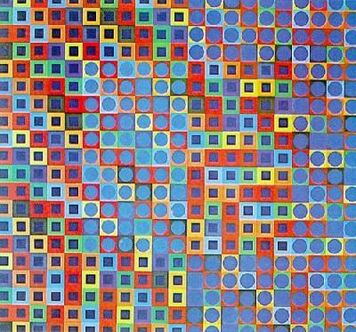
Zebegen by Vasarely
- The tricky bit: registration or getting everything to line up. You'd need to draw your grid in light pencil and think up a scheme so that the print place get placed in just the right place...
- HINT: You might want to consider a print paper that is slightly coloured as opposed to stark white (this depends on the look you want to create) — above, in Orion C the paper appears to be cream.
- NOTE: The work to the side, "Saphir" requires both a positive and negative print plate. See below for instructions.
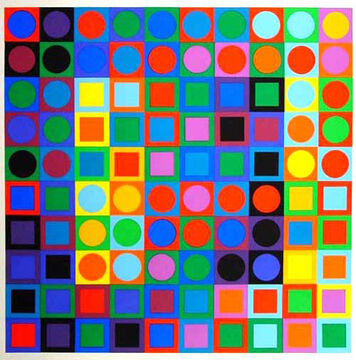
Vasarely
My personal favorite, but then I LOVE colour....
- Same discussion of design principles as above — have students to trace out areas of all squares, all circles, bright and dark areas with their fingers.
- This would require both positive and negative print plates (a plate for the figure (the circle) and a plate for the surround or background (negative print).
- These would be quite easy to produce. For the positive plate: Trace around your wooden circle (or small inner square) on the print foam with a pencil; cut with scissors and affix circle to square plate. For the negative plate: cut out square of print foam in the proper grid size (e.g. 4" x4"); attach to rigid backing of the same size; press wooden circle into print foam square (hopefully, dead in the center). You'll need to think about how to do that alignment.
- Even very young children can do the overall design and the actual printing. It won't be exact, but it will definitely be interesting and charming.
Some other works to think about....
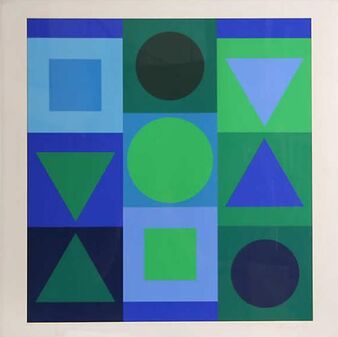
Saphir by Vasaley
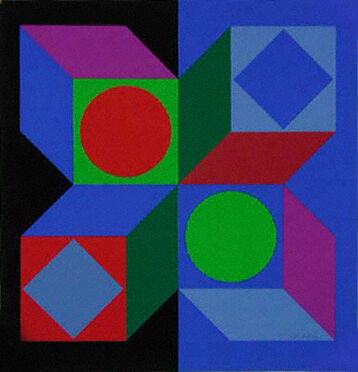
Lapidarea by Vasarely